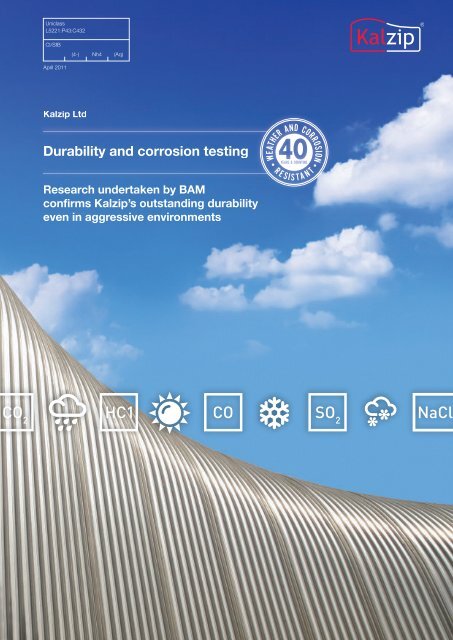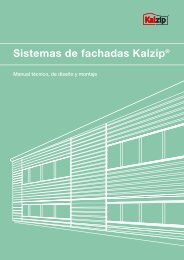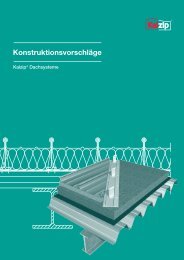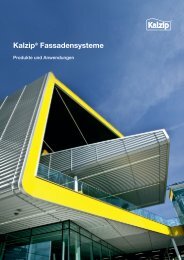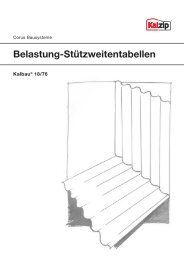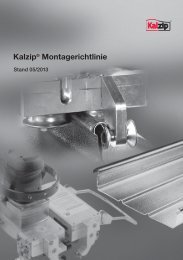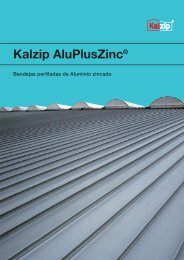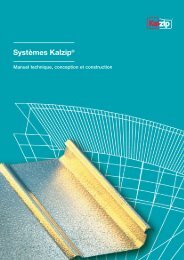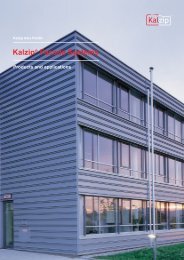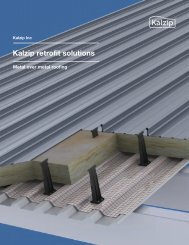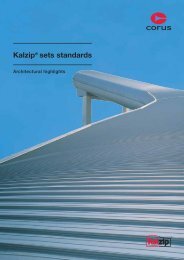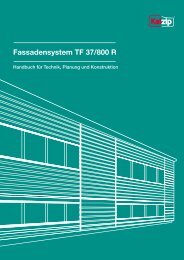Download PDF - Kalzip
Download PDF - Kalzip
Download PDF - Kalzip
You also want an ePaper? Increase the reach of your titles
YUMPU automatically turns print PDFs into web optimized ePapers that Google loves.
WEATHER AND CORROSIONUniclassL5221:P43:C432CI/SfB(4-) Nh4 (Aq)April 2011<strong>Kalzip</strong> LtdDurability and corrosion testingResearch undertaken by BAMconfirms <strong>Kalzip</strong>’s outstanding durabilityeven in aggressive environmentsRE SISTT A NCO 2HC1COSO 2NaCl
RWEATHER AND CORROSIONE SISTT A N<strong>Kalzip</strong> ® – proven to last, whatever<strong>Kalzip</strong> aluminium standing seamroofing and wall cladding hasrevolutionised the design of buildingenvelopes, making possible someof the world’s most dramaticarchitecture. But perhaps even moreimportant is its inherent durability,delivering virtually maintenance-freeperformance for decade after decade.40 years’ exposure andstill performing.The latest findings of a long-termproject by German technical researchbody BAM (Federal Institute forMaterials Research and Testing)show that, even after 40 years’exposure to potentially corrosiveindustrial pollutants and atmosphericattack, the base material of a <strong>Kalzip</strong>roof – and therefore its ability toperform – remains fully functional.Aluminium is inherently durable and weatherresistant,creating an inert, hard oxide layerthat resists most pollutants and ‘regeneratesif cut or scratched. With <strong>Kalzip</strong>, an additionalweathering layer of bespoke alloy furtherimproves this resistance to corrosion, resultingin a BBA-certified life expectancy in excessof 40 years.Experience suggests this to be a conservativeestimate – <strong>Kalzip</strong> roofs have already exceededthat life expectancy – and the findings of theBAM report confirm this.The research undertaken by BAM investigatedthe condition of roof samples taken frombuildings in three locations, selected for theirdifferent atmospheric conditions and the threatsthat these present, e.g. humidity, rainfall, attackby chemical pollution, UV radiation etc.And the results clearly show that the <strong>Kalzip</strong>aluminium roofing tested remains in goodworking order, 40 years or more from the dayit was first installed. This document providesa summary of the findings published in BAM-TestCertificate VI.1/14669.Fig. 1 Fig. 2 Fig. 3 Fig. 4 Fig. 5
Wthe conditionsPacking Hall, HamburgCongress Hall, NurembergStorage Facility, EssenNaCl CO 2CO HC1SO 2This plated aluminium <strong>Kalzip</strong> roof, at apacking hall in the Freeport of Hamburg,was installed in 1970. While its locationis classed as an urban climate, the hallis actually situated in the harbour area,a marine environment where sodiumchloride is the major atmospheric pollutant.Tests carried out on a storage hall atHamburg’s container terminal in 1972(Fig. 1, after 1 years’ exposure), showedearly signs of pitting corrosion; similar tests21 years later (Fig. 2) showed further pitting,but still no damage to the core material.While the 2009 samples were takenfrom a different structure, they are stillrepresentative in terms of age andatmospheric exposure conditions. The firstsample (Fig. 3) was taken from an area ofthe eaves and shows further increase incorrosion, both on the inner and the outerside. The second (Fig. 4), taken from themiddle of the roof, shows similar corrosionto the outer side but limited damage to theinner side.Again, pitting and corrosion is restrictedto the protective layer; the bulk materialremains completely unaffected.BAM expert opinionAfter 40 years of exposure, the bulk materialis not yet affected… At the present momentthe function of the roof is completely in agood condition.The <strong>Kalzip</strong> roof on Congress Hall,Nuremberg was installed in 1968.The climate in this location is a mixtureof urban and rural and the main pollutantsare carbon monoxide and carbon dioxide,neither of which has any major effecton aluminium.Initial tests carried out in 1993 (Fig. 5)showed that pitting corrosion was restrictedto the plating layer and did not extend tothe underlying bulk material.In 2009, three further samples were taken,allowing assessment of the roof after 41years’ exposure. The first two samples(Fig. 6 and Fig. 7) were taken from eavesadjacent to the earlier tests and pittingcorrosion remains limited to the platinglayer. The third sample (Fig. 8) was takenfrom a seam and the protected inner sideof the sheet shows no sign of corrosion.The freely weathered upper side showspitting typical for this location, none ofwhich reaches the bulk material.So, in every sample taken, the weatheringlayer – designed to protect the purer basematerial – continues to do its job.BAM expert opinionThe pitting corrosion effects in the platinglayer detected in the cross section stop atthe bulk material and thus do not affectthe function of the roofing after 41 yearsof use… long durability can be expected.Testing at the third location, Essen, wascarried out on a roof at a metal storagefacility erected in 1974. The climate at thisinstallation is classified as industrial, wherethe most frequently encountered pollutantsare sulphur dioxide and hydrogen chloride.Tests in 1972 and 1993 were carried outon a different building, also in Essen, butaccess was no longer possible. While theEssen location is the same, there is aneight year age difference between the twobuildings tested so a direct comparisonis not possible.The first sample (Fig. 9) was taken fromthe eaves of the storage facility; while pittingto the plating layer is apparent on bothsides, the core material remains unaffected;the second sample (Fig. 10), taken from themiddle of the roof, shows pitting to theoutside but only very limited damage to theinside, neither affecting the bulk material.BAM expert opinionThe investigations reveal numerouscorrosion effects which, however, do notextend to the bulk material.Fig. 6 Fig. 7 Fig. 8 Fig. 9 Fig. 10
www.kalzip.comCare has been taken to ensure that thisinformation is accurate, but Tata SteelEurope Limited – including itssubsidiaries – does not acceptresponsibility for information whichis found to be misleading.Copyright 2011<strong>Kalzip</strong> Alclad alloy<strong>Kalzip</strong>’s resistance to corrosion is achieved by cladding the basematerial with a sacrificial layer of AlZn1 (aluminium zinc alloy).The improved protection comes from the negative potentialof AlZn1 of 150 mV towards the base material of AlMn1Mg1.Upon appearance of an aggressive medium, the AlZn1 layersacrifices itself as anodes, thereby allowing the functioningof the cathode material AlMn1Mg1 to remain intact.The investigations undertaken by BAM found there was“no significant corrosion progress” on the <strong>Kalzip</strong> projecting roofinstalled at the south wing of the Congress Hall in Nuremberg.And while pitting corrosion was detected on the roofs of thepacking hall at Hamburg freeport and the metal trade storagefacility in Essen, in both cases the damage was restricted to theplating layer.Overall, the Federal Institute for Materials Research and Testing(BAM) concluded that: “From the corrosion point of view theroofings are still working well after 36 to 41 years’ exposureunder atmospheric conditions.”<strong>Kalzip</strong> testing and accreditationThe BAM evaluation and report is just one example of theindependent tests to which <strong>Kalzip</strong> is regularly subjected.<strong>Kalzip</strong> LtdHaydock LaneHaydockSt HelensMerseyside WA11 9TYT +44 (0) 1942 295500F +44 (0) 1942 295508Email: enquiries.uk@kalzip.comwww.kalzip.comThe <strong>Kalzip</strong> roof system in its entirety has achieved third partycertification by the BBA in the UK and is globally recognisedby the German Zulassung, French Avis Technique and FactoryMutual quality standards.


